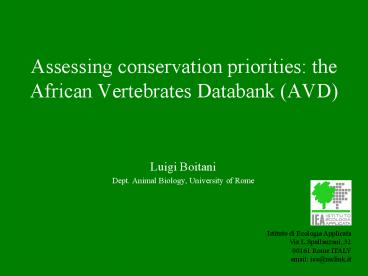Assessing conservation priorities: the African Vertebrates Databank AVD - PowerPoint PPT Presentation
1 / 23
Title:
Assessing conservation priorities: the African Vertebrates Databank AVD
Description:
Area of Occupancy of the Cheetah. Acinonyx jubatus. Probabilistic Continuous Model ... Endangered (EN: C2a, D1) as A. j. hencki NW African cheetah. Management tools ... – PowerPoint PPT presentation
Number of Views:75
Avg rating:3.0/5.0
Title: Assessing conservation priorities: the African Vertebrates Databank AVD
1
Assessing conservation priorities the African
Vertebrates Databank (AVD)
- Luigi Boitani
- Dept. Animal Biology, University of Rome
Istituto di Ecologia Applicata Via L.Spallanzani,
32 00161 Rome ITALY email iea_at_mclink.it
2
Participating Institutions
- IUCN/SSC
- Conservation International - CABS
- Natural History Museum London
- University of Cambridge
- Natural History Museum Copenhagen
- Birdlife International
- Istituto di Ecologia Applicata
- University of Rome
3
Project goals
- Produce a continental scale conservation tool for
African vertebrates - This major goal is achieved by
- building a data bank on African vertebrates with
the aim of providing the raw data for future
applications and analyses on conservation options
and priorities - modeling actual and potential species distribution
4
Conservation Needs
- Broad scale planning (eventually global)
- Metapopulation approach
- Identification of core areas and corridors
- .
- which implies
- Detailed knowledge on actual species distribution
- Extensive data on species ecology and biology
- Spatially explicit predicting tools
5
GIS modeling
- Cost effective approach
- Maximizes the information obtainable from the few
data sets available - Updateable distributions
- Repeatable approach
6
Three (four) pieces of information
- Species Extent of Occurrence
- Environmental variables
- Species-environment relationship
- Validation data set and procedures
7
Other projects with similar approach
- African Mammal Databank (1999)
- Ecological Network for the Italian Vertebrates
(current) - Asian Mammal Databank (submitted to the EU)
8
Distribution modeling
- AVD integrates two (maybe three) levels
- "Blotch" distribution
- Categorical-Discrete distributions obtained
through a deterministic approach based on GIS
overlay procedures - and maybe
- Probabilistic-Continuous distribution models
based on statistically supported GIS overlay
procedures.
9
Blotch distribution
10
Categorical Discrete Model
11
Probabilistic Continuous Model
12
Categorical Discrete ModelValidation
- The AMD project was validated with field work
carried out in four selected countries in Africa - Botswana, Cameroon, Morocco, Uganda
- 427 plots were allocated at random within the
four countries - The presence/absence of each species at each of
the predetermined points was verified by - direct observation
- in loco collection of publications and scientific
reports - interviews with local experts/authorities/inhabita
nts - In each country a team composed by a researcher
from a local Institution and one IEA staff member
carried out the field work
13
Categorical Discrete ModelValidation
14
Categorical Discrete ModelValidation
- The AVD limited budget resources will prevent
direct field work - Similar scheme will be implemented using known
species locations from bibliography
15
Categorical Discrete ModelProducts
16
Categorical Discrete ModelProducts
17
Categorical Discrete ModelProducts
18
Management tools
- The different types of distribution models
produced can be included in management tools of
increasing information content - Blotch distribution
- hot spots identification
- effectiveness of protected areas
- Categorical Discrete Distribution Model
- population fragmentation
- management strategies for conservation
- Probabilistic Continuous Distribution Model
- metapopulation PVA
- corridors identification
19
Mammals biodiversity hotspots
- 281 species of large mammals
20
Mammals biodiversity hotspots
- 281 species of large mammals
21
AMD Products
- a printed volume containing for each of the 281
species - Taxonomic notes
- IUCN threat category
- Available ecological information
- Bibliography
- Extent of Occurrence (Blotch)
- Categorical Discrete Model
- Probabilistic Continuous Model
- Comments and conservation issues
- set of 10 CD-ROM with the digital version of all
the above information - web site with all data sets
- www.gisbau.uniroma1.it/amd
22
AVD where we are ?
- Mammals
- Rodents
- Bats
- Insectivores
- Others
- Birds
- Amphibians
- Herps
- Snakes
- Lizards
- Others ?
- Fishes ??
23
Why modeling? And how
- Purpose of distribution maps
- .
- .
- ? conservation maps must be current and at the
appropriate resolution/scale for each taxon - Maps ARE models !!
- Increasing distribution information
- Points (if qualified date, accuracy, species
biology) (good for transformation into blotches
and/or for inductive modeling and/or for model
validation) - Polygons (if qualified)
- Grids (if all cells are qualified)
- Models (if validated)






























![Eleanor McGregor [Director: Conservation] PowerPoint PPT Presentation](https://s3.amazonaws.com/images.powershow.com/8026054.th0.jpg?_=20160801045)
